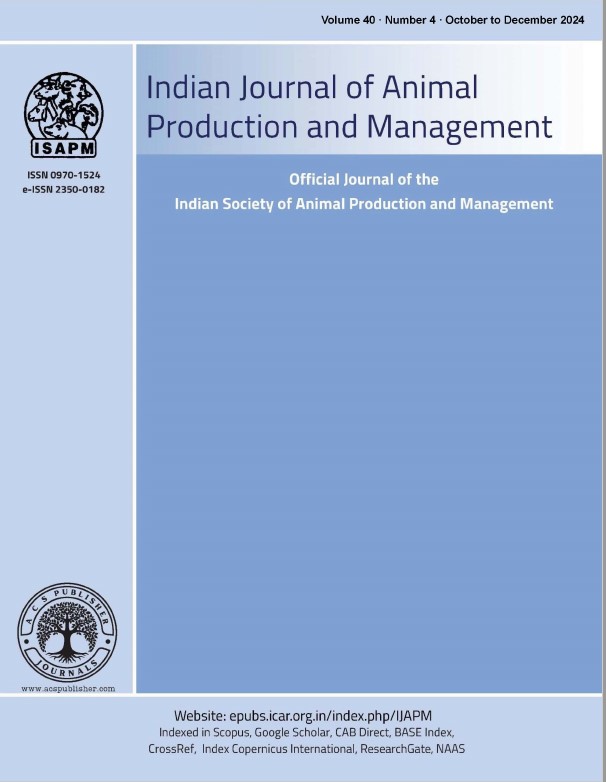Consumer Perception towards Fresh Meat and Processed Meat Consump tion in the city of Tirupati, India
DOI:
https://doi.org/10.48165/ijapm.2025.41.1.8Keywords:
Consumer, consumption pattern, meat, food safetyAbstract
A study was conducted to understand consumer perception towards meat and meat products consumption in Tirupati city. The city of Tirupati has witnessed a sharp rise in the households which is evident with the rapid expansion of the city outskirts by means of real-estate developments. This pose a greater scope for meat startups to be established in the rapidly developing city. A total of 200 respondents were randomly selected and were interviewed. Data were collected using pre- tested structured interview schedule by personal interviews. The study group comprised of 76 males & 124 females. The educational background of respondents was found to vary between uneducated to PG & PhD level. The overall mean age of the consumers was found to be (33.5) of which majority (45%) belong to middle age group. The study revealed that most of the consumers ate meat for taste (67%) and health benefits (33%) and usually consume meat twice in a week (51%). The most preferred meat was chicken (53%), followed by chevon (21%), sea foods (fish, prawns 16%) and other meat (10%). Gravy type meat products were most preferred, followed by biryani (19%) and fried meat products (15%). Most of the consumers (63%) opined that meat have good cholesterol (HDL) and (28%) as bad cholesterol (LDL) whereas (9%) opined as both. The willingness to purchase chilled/ frozen meat was very low (5%). The acceptance of the respondents towards processed meat products such as pickles (80%), comminuted meat products at (20%) respectively. The majority of the respondents (82%) believed that over consuming of meat leads to heart problems and other diseases. Unfortunately (78%) of the respondents have no idea about what kind of vitamins and minerals are present in meat. Most of the consumers said that ideal method for cooking is boiling (78%) and frying (22%). Only (40%) of the respondents have awareness about zoonotic diseases. Food safety has emerged as an important global issue with international trade and public health implications. The current study also revealed that most of the respondents have no idea about laws pertaining to food safety. The. results indicated that most respondents consume meat for taste and as a cultural tradition. However, majority of the consumers lack scientific backdrop about fresh meat and processed meat, which further can be overcome by conducting extensive awareness programmes and advertisements by the government agencies and entrepreneurs in the meat trade. The consumer awareness about scientific handling of meat can safeguard their health and also pave a way for huge investments in the meat startups in the developing cities.
References
Babu, A. J., Sundari, A. R., Triveni, G., & Indumathi, J. (2010). Study on meat consumption patterns in rural households of Chittoor District of Andhra Pradesh. Tamilnadu Journal of Veterinary and Animal Sciences, 6(4), 183–187.
Chemnitz, C., & Becheva, S. (2014). Meat Atlas. Retrieved February 24, 2014, from www.foeeurope.org/meatatlas
De Silva, P. H. G. J., Atapattu, N. S. B. M., & Sandika, A. L. (2010). A study of the socio-cultural parameters associated with meat purchasing and consumption pattern: A case of southern province. Sri Lankan Journal of Agricultural Science, 5(2), 71–79.
Devi, S. M., Balachandar, V., Lee, S. I., & Kim, I. H. (2014). An outline of meat consumption in the Indian population—A pilot review. Korean Journal of Food Science and Animal Resources, 34(4), 507–515.
Eswara Rao, B., Bhaskar, K., Naga Mallika, E., Naveen, Z., & Gupta, R. S. D. (2017). A study on consumption pattern of meat in and around rural locality of Gannavaram (Andhra Pradesh). Chemical Science Reviews and Letters, 6(23), 1363–1368.
Godfray, H. C. J., Aveyard, P., Garnett, T., Hall, J. W., Key, T. J., Lorimer, J., Pierrehumbert, R. T., Scarborough, P., Springmann, M., & Jebb, S. A. (2018). Meat consumption, health, and the environment. Science, 361(243), 1–8.
Gossard, H. M., & York, R. (2003). Social structural influences on meat consumption. Human Ecology Review, 10(1), 1–9.
Islam, M. M., Anjum, S., Modi, R. J., & Wadhwani, K. N. (2016). Scenario of livestock and poultry in India and their contribution to the national economy. International Journal of Science Environment and Technology, 5, 956–965.
Jayanthi, R., Chandirasekaran, V., & Boopathy Raja, M. (2024). Meat consumption pattern among students of Veterinary College and Research Institute, Tirunelveli. Journal of Krishi Vigyan, 12(2).
Jackson, J., Williams, R., McEvoy, M., MacDonald-Wicks, L., & Patterson, A. (2016). Is higher consumption of animal flesh foods associated with better iron status among adults in developed countries? A systematic review. Nutrition, 8(89), 1–27.
Kiran, M., Prabhu, M. K. N., Paramesha, S. C., Rajshekar, T., Praveen, M. P., & Punitkumar, C. (2018). Consumption pattern, consumer attitude and consumer perception on meat quality and safety in Southern India. International Food Research Journal, 25(3), 1026–1030.
Liang, D., Li, T., & Gai, L. (2014). Characteristics and influencing factors of rural residents beef consumption. Food and Nutrition in China, 20(5), 50–52.
Mittal, S. (2006). Structural shift in demand for food: Projections for 2020. Working Paper No. 184. Indian Council for Research on International Economic Relations, New Delhi.
Priyadharsini, S., Kathiravan, G., Thirunavukkarasu, P., & Ganpat, W. (2016). Evaluation of determinants influence for consumption of livestock products in second tier cities of Tamil Nadu, India. Bangladesh Journal of Animal Science, 5(3), 25–30.
Sharma, S., Pathak, V., Singh, V. P., Awasthi, M., & Bharti, S. (2018). Comparative quality assessment of meat nuggets prepared from meat of different food animals. International Journal of Livestock Research, 8(1), 139–148.
Srinivasa, R. M., & Thammiraju, D. (2010). Meat consumption pattern in Hyderabad city. Indian Journal of Animal Research, 44(4), 248–253.
Talukder, S., & Mendiratta, S. (2017). Exploring purple leaf sand cherry (Prunus cistena) extracts based indicator to monitor meat quality during storage at 10 ± 1 °C. International Journal of Livestock Research, 7(8), 214–220.
Thammiraju, D., & Suryanarayana, M. V. A. N. (2005). Meat consumption in Prakasam district of Andhra Pradesh: An analysis. Livestock Research for Rural Development, 17(Article 130).
Teklebrhan, T. (2013). Consumer perceptions and preferences of meat types in Harar and Haramaya towns, Ethiopia. Journal of Microbiology, Biotechnology and Food Sciences, 2(3), 959–969.
Wu, Q., & Xiao, H. (2013). Characteristics and influence factors of mutton consumption of China’s urban and rural residents. Agricultural Outlook, 8, 71–75.
Zhang, H., Sun, S., & Feng, Y. (2014). Analysis of mutton consumption habit and buying behavior in urban and rural area. Xinjiang State Farms Economy, 1, 46–51.

